HA2011 Management Accounting Assignment Solution, Holmes Institute
VerifiedAdded on 2022/11/01
|17
|4423
|351
Homework Assignment
AI Summary
This document presents a comprehensive solution to a Management Accounting assignment, focusing on cost concepts and value chain analysis. The assignment explores the value chain concept, evaluating its application within the Treasury Wine Estate Company, including its mission, objectives, competitive strategies, and value-adding processes. It delves into cost allocation, including calculating predicted allocation rates for fixed and variable overhead, determining total overhead and total costs for a specific job, and selecting appropriate cost pools and drivers. The analysis considers three cost objects, identifying cost pools and drivers, and calculating allocation rates. The solution incorporates tables and figures to illustrate calculations and concepts, providing a detailed examination of cost accounting principles and their practical application in a business context.
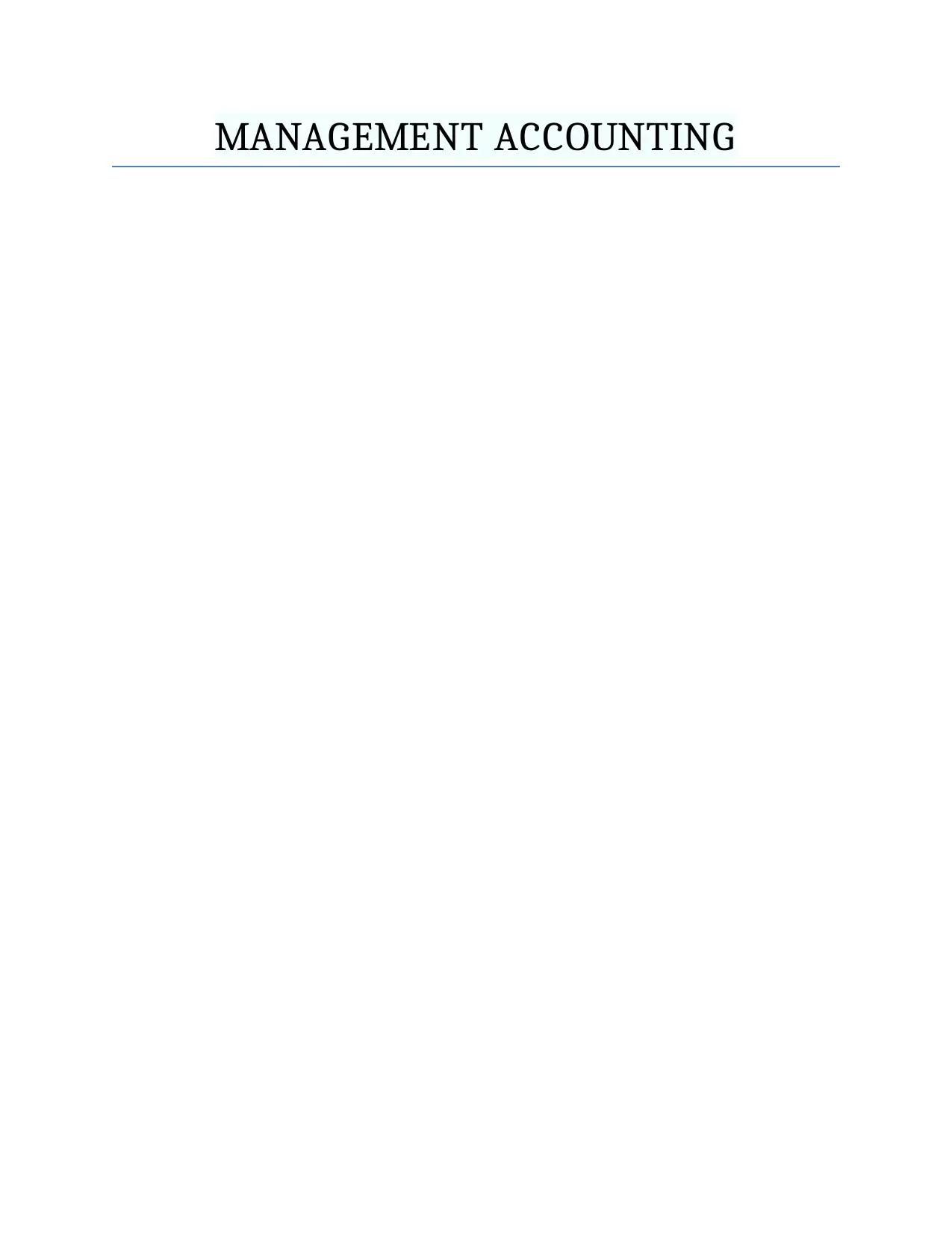
MANAGEMENT ACCOUNTING
Paraphrase This Document
Need a fresh take? Get an instant paraphrase of this document with our AI Paraphraser
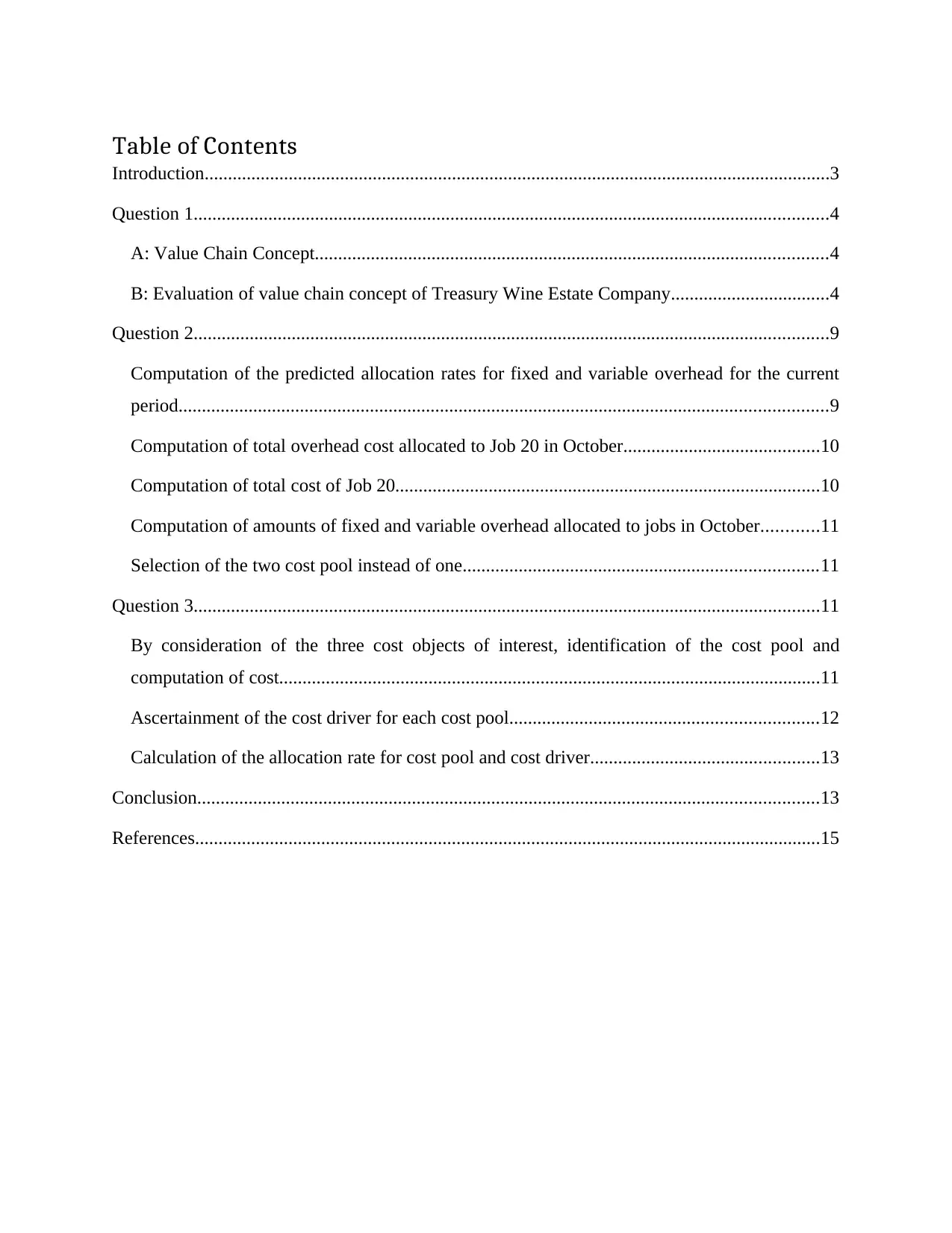
Table of Contents
Introduction......................................................................................................................................3
Question 1........................................................................................................................................4
A: Value Chain Concept..............................................................................................................4
B: Evaluation of value chain concept of Treasury Wine Estate Company..................................4
Question 2........................................................................................................................................9
Computation of the predicted allocation rates for fixed and variable overhead for the current
period...........................................................................................................................................9
Computation of total overhead cost allocated to Job 20 in October..........................................10
Computation of total cost of Job 20...........................................................................................10
Computation of amounts of fixed and variable overhead allocated to jobs in October............11
Selection of the two cost pool instead of one............................................................................11
Question 3......................................................................................................................................11
By consideration of the three cost objects of interest, identification of the cost pool and
computation of cost....................................................................................................................11
Ascertainment of the cost driver for each cost pool..................................................................12
Calculation of the allocation rate for cost pool and cost driver.................................................13
Conclusion.....................................................................................................................................13
References......................................................................................................................................15
Introduction......................................................................................................................................3
Question 1........................................................................................................................................4
A: Value Chain Concept..............................................................................................................4
B: Evaluation of value chain concept of Treasury Wine Estate Company..................................4
Question 2........................................................................................................................................9
Computation of the predicted allocation rates for fixed and variable overhead for the current
period...........................................................................................................................................9
Computation of total overhead cost allocated to Job 20 in October..........................................10
Computation of total cost of Job 20...........................................................................................10
Computation of amounts of fixed and variable overhead allocated to jobs in October............11
Selection of the two cost pool instead of one............................................................................11
Question 3......................................................................................................................................11
By consideration of the three cost objects of interest, identification of the cost pool and
computation of cost....................................................................................................................11
Ascertainment of the cost driver for each cost pool..................................................................12
Calculation of the allocation rate for cost pool and cost driver.................................................13
Conclusion.....................................................................................................................................13
References......................................................................................................................................15
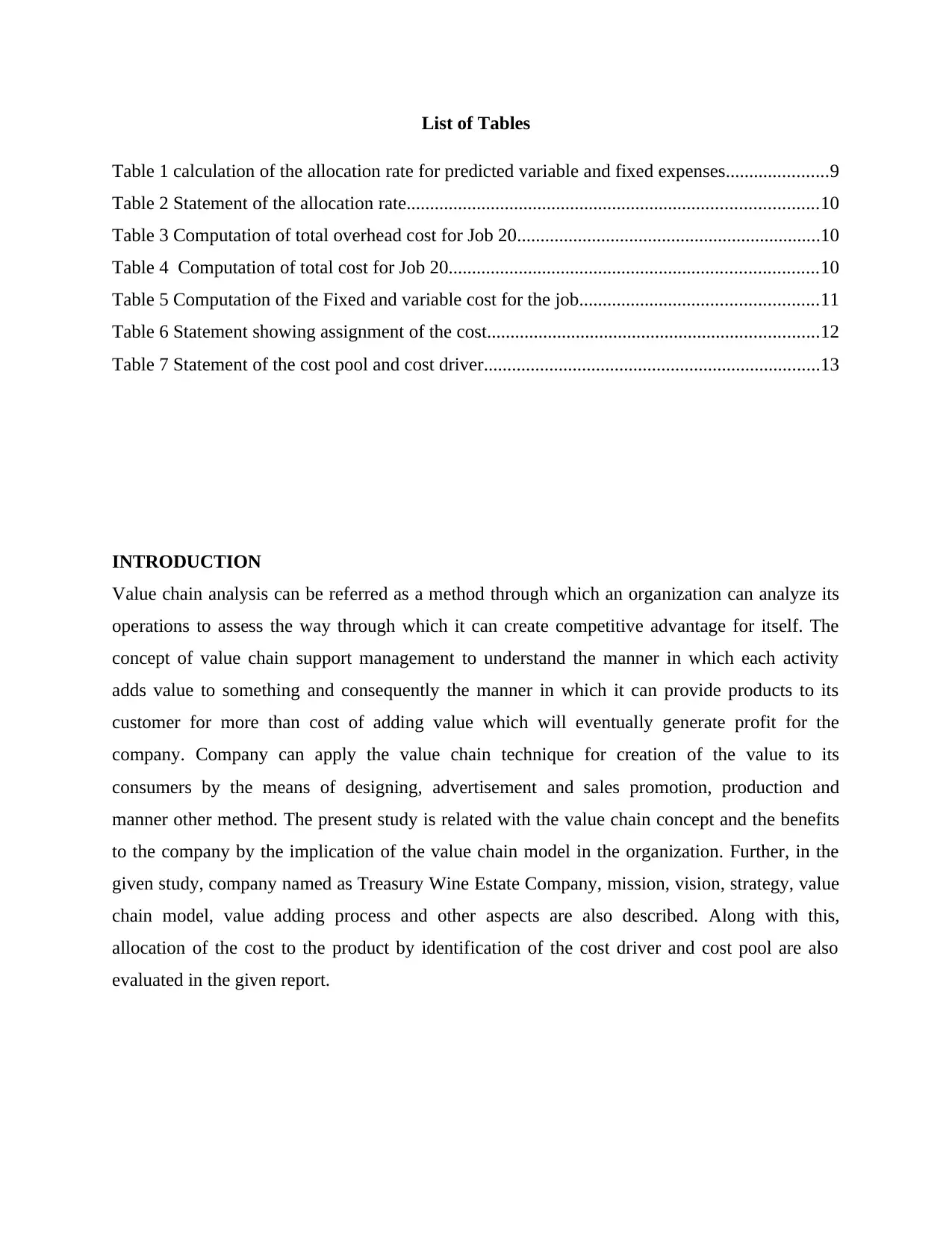
List of Tables
Table 1 calculation of the allocation rate for predicted variable and fixed expenses......................9
Table 2 Statement of the allocation rate........................................................................................10
Table 3 Computation of total overhead cost for Job 20.................................................................10
Table 4 Computation of total cost for Job 20...............................................................................10
Table 5 Computation of the Fixed and variable cost for the job...................................................11
Table 6 Statement showing assignment of the cost.......................................................................12
Table 7 Statement of the cost pool and cost driver........................................................................13
INTRODUCTION
Value chain analysis can be referred as a method through which an organization can analyze its
operations to assess the way through which it can create competitive advantage for itself. The
concept of value chain support management to understand the manner in which each activity
adds value to something and consequently the manner in which it can provide products to its
customer for more than cost of adding value which will eventually generate profit for the
company. Company can apply the value chain technique for creation of the value to its
consumers by the means of designing, advertisement and sales promotion, production and
manner other method. The present study is related with the value chain concept and the benefits
to the company by the implication of the value chain model in the organization. Further, in the
given study, company named as Treasury Wine Estate Company, mission, vision, strategy, value
chain model, value adding process and other aspects are also described. Along with this,
allocation of the cost to the product by identification of the cost driver and cost pool are also
evaluated in the given report.
Table 1 calculation of the allocation rate for predicted variable and fixed expenses......................9
Table 2 Statement of the allocation rate........................................................................................10
Table 3 Computation of total overhead cost for Job 20.................................................................10
Table 4 Computation of total cost for Job 20...............................................................................10
Table 5 Computation of the Fixed and variable cost for the job...................................................11
Table 6 Statement showing assignment of the cost.......................................................................12
Table 7 Statement of the cost pool and cost driver........................................................................13
INTRODUCTION
Value chain analysis can be referred as a method through which an organization can analyze its
operations to assess the way through which it can create competitive advantage for itself. The
concept of value chain support management to understand the manner in which each activity
adds value to something and consequently the manner in which it can provide products to its
customer for more than cost of adding value which will eventually generate profit for the
company. Company can apply the value chain technique for creation of the value to its
consumers by the means of designing, advertisement and sales promotion, production and
manner other method. The present study is related with the value chain concept and the benefits
to the company by the implication of the value chain model in the organization. Further, in the
given study, company named as Treasury Wine Estate Company, mission, vision, strategy, value
chain model, value adding process and other aspects are also described. Along with this,
allocation of the cost to the product by identification of the cost driver and cost pool are also
evaluated in the given report.
⊘ This is a preview!⊘
Do you want full access?
Subscribe today to unlock all pages.

Trusted by 1+ million students worldwide
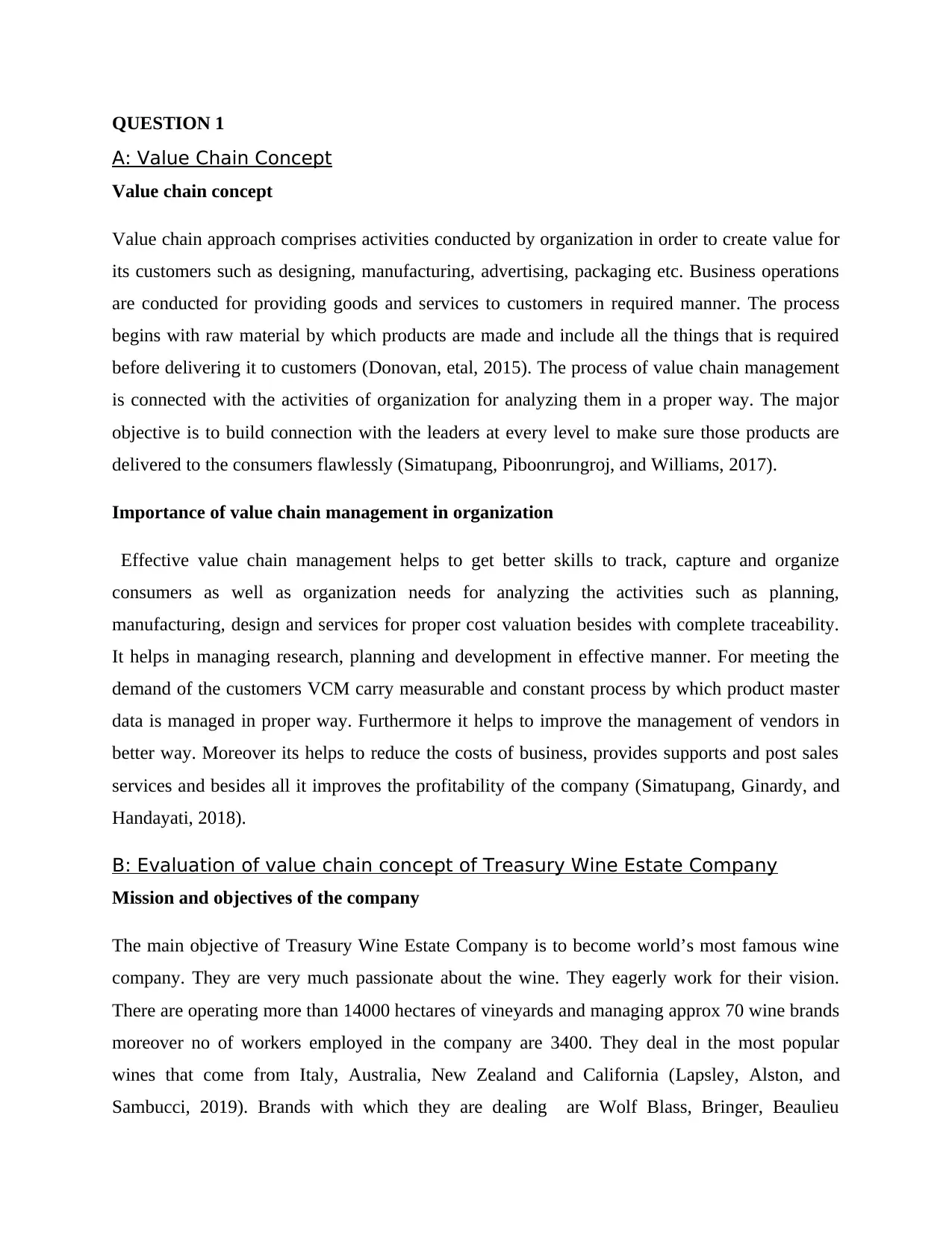
QUESTION 1
A: Value Chain Concept
Value chain concept
Value chain approach comprises activities conducted by organization in order to create value for
its customers such as designing, manufacturing, advertising, packaging etc. Business operations
are conducted for providing goods and services to customers in required manner. The process
begins with raw material by which products are made and include all the things that is required
before delivering it to customers (Donovan, etal, 2015). The process of value chain management
is connected with the activities of organization for analyzing them in a proper way. The major
objective is to build connection with the leaders at every level to make sure those products are
delivered to the consumers flawlessly (Simatupang, Piboonrungroj, and Williams, 2017).
Importance of value chain management in organization
Effective value chain management helps to get better skills to track, capture and organize
consumers as well as organization needs for analyzing the activities such as planning,
manufacturing, design and services for proper cost valuation besides with complete traceability.
It helps in managing research, planning and development in effective manner. For meeting the
demand of the customers VCM carry measurable and constant process by which product master
data is managed in proper way. Furthermore it helps to improve the management of vendors in
better way. Moreover its helps to reduce the costs of business, provides supports and post sales
services and besides all it improves the profitability of the company (Simatupang, Ginardy, and
Handayati, 2018).
B: Evaluation of value chain concept of Treasury Wine Estate Company
Mission and objectives of the company
The main objective of Treasury Wine Estate Company is to become world’s most famous wine
company. They are very much passionate about the wine. They eagerly work for their vision.
There are operating more than 14000 hectares of vineyards and managing approx 70 wine brands
moreover no of workers employed in the company are 3400. They deal in the most popular
wines that come from Italy, Australia, New Zealand and California (Lapsley, Alston, and
Sambucci, 2019). Brands with which they are dealing are Wolf Blass, Bringer, Beaulieu
A: Value Chain Concept
Value chain concept
Value chain approach comprises activities conducted by organization in order to create value for
its customers such as designing, manufacturing, advertising, packaging etc. Business operations
are conducted for providing goods and services to customers in required manner. The process
begins with raw material by which products are made and include all the things that is required
before delivering it to customers (Donovan, etal, 2015). The process of value chain management
is connected with the activities of organization for analyzing them in a proper way. The major
objective is to build connection with the leaders at every level to make sure those products are
delivered to the consumers flawlessly (Simatupang, Piboonrungroj, and Williams, 2017).
Importance of value chain management in organization
Effective value chain management helps to get better skills to track, capture and organize
consumers as well as organization needs for analyzing the activities such as planning,
manufacturing, design and services for proper cost valuation besides with complete traceability.
It helps in managing research, planning and development in effective manner. For meeting the
demand of the customers VCM carry measurable and constant process by which product master
data is managed in proper way. Furthermore it helps to improve the management of vendors in
better way. Moreover its helps to reduce the costs of business, provides supports and post sales
services and besides all it improves the profitability of the company (Simatupang, Ginardy, and
Handayati, 2018).
B: Evaluation of value chain concept of Treasury Wine Estate Company
Mission and objectives of the company
The main objective of Treasury Wine Estate Company is to become world’s most famous wine
company. They are very much passionate about the wine. They eagerly work for their vision.
There are operating more than 14000 hectares of vineyards and managing approx 70 wine brands
moreover no of workers employed in the company are 3400. They deal in the most popular
wines that come from Italy, Australia, New Zealand and California (Lapsley, Alston, and
Sambucci, 2019). Brands with which they are dealing are Wolf Blass, Bringer, Beaulieu
Paraphrase This Document
Need a fresh take? Get an instant paraphrase of this document with our AI Paraphraser
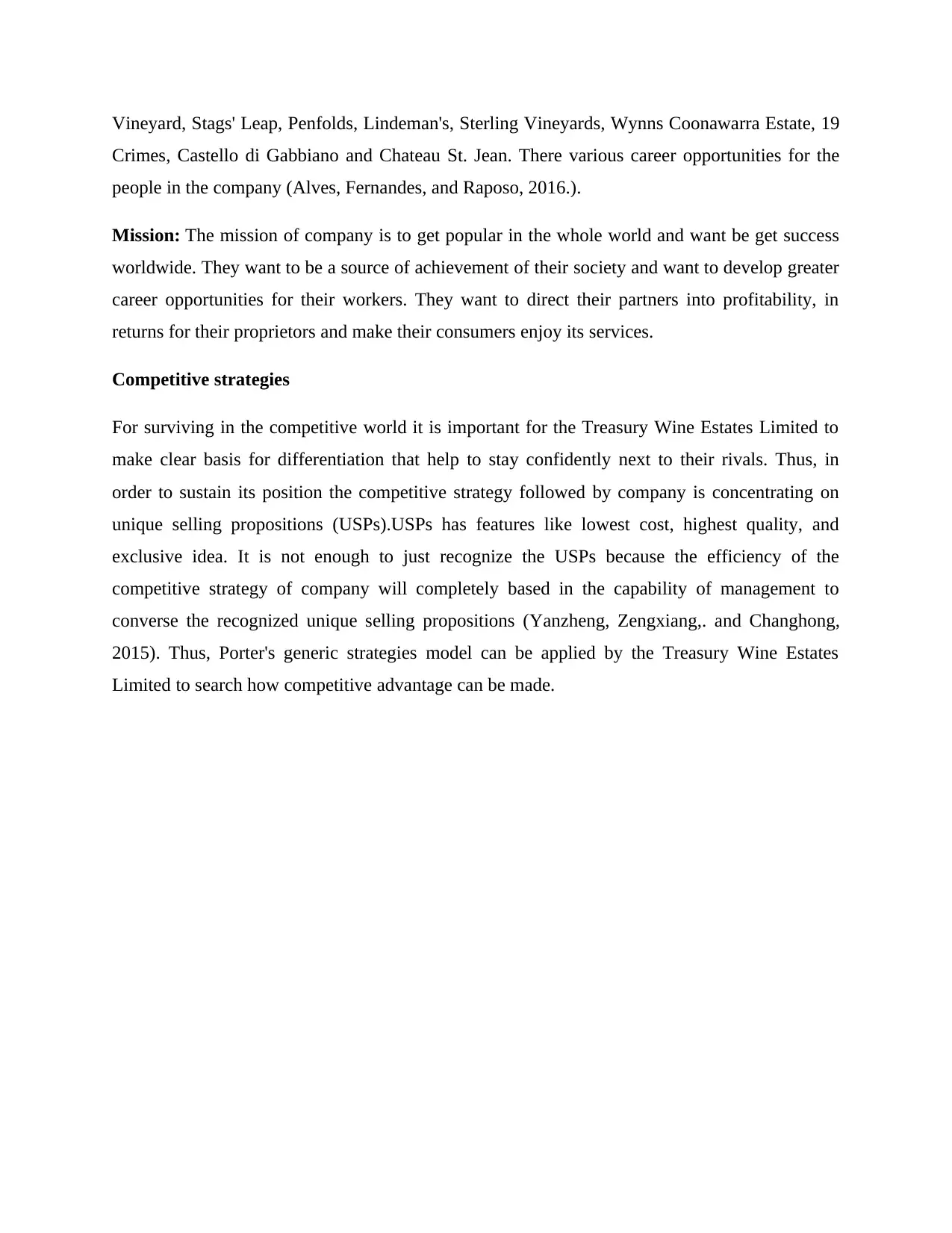
Vineyard, Stags' Leap, Penfolds, Lindeman's, Sterling Vineyards, Wynns Coonawarra Estate, 19
Crimes, Castello di Gabbiano and Chateau St. Jean. There various career opportunities for the
people in the company (Alves, Fernandes, and Raposo, 2016.).
Mission: The mission of company is to get popular in the whole world and want be get success
worldwide. They want to be a source of achievement of their society and want to develop greater
career opportunities for their workers. They want to direct their partners into profitability, in
returns for their proprietors and make their consumers enjoy its services.
Competitive strategies
For surviving in the competitive world it is important for the Treasury Wine Estates Limited to
make clear basis for differentiation that help to stay confidently next to their rivals. Thus, in
order to sustain its position the competitive strategy followed by company is concentrating on
unique selling propositions (USPs).USPs has features like lowest cost, highest quality, and
exclusive idea. It is not enough to just recognize the USPs because the efficiency of the
competitive strategy of company will completely based in the capability of management to
converse the recognized unique selling propositions (Yanzheng, Zengxiang,. and Changhong,
2015). Thus, Porter's generic strategies model can be applied by the Treasury Wine Estates
Limited to search how competitive advantage can be made.
Crimes, Castello di Gabbiano and Chateau St. Jean. There various career opportunities for the
people in the company (Alves, Fernandes, and Raposo, 2016.).
Mission: The mission of company is to get popular in the whole world and want be get success
worldwide. They want to be a source of achievement of their society and want to develop greater
career opportunities for their workers. They want to direct their partners into profitability, in
returns for their proprietors and make their consumers enjoy its services.
Competitive strategies
For surviving in the competitive world it is important for the Treasury Wine Estates Limited to
make clear basis for differentiation that help to stay confidently next to their rivals. Thus, in
order to sustain its position the competitive strategy followed by company is concentrating on
unique selling propositions (USPs).USPs has features like lowest cost, highest quality, and
exclusive idea. It is not enough to just recognize the USPs because the efficiency of the
competitive strategy of company will completely based in the capability of management to
converse the recognized unique selling propositions (Yanzheng, Zengxiang,. and Changhong,
2015). Thus, Porter's generic strategies model can be applied by the Treasury Wine Estates
Limited to search how competitive advantage can be made.
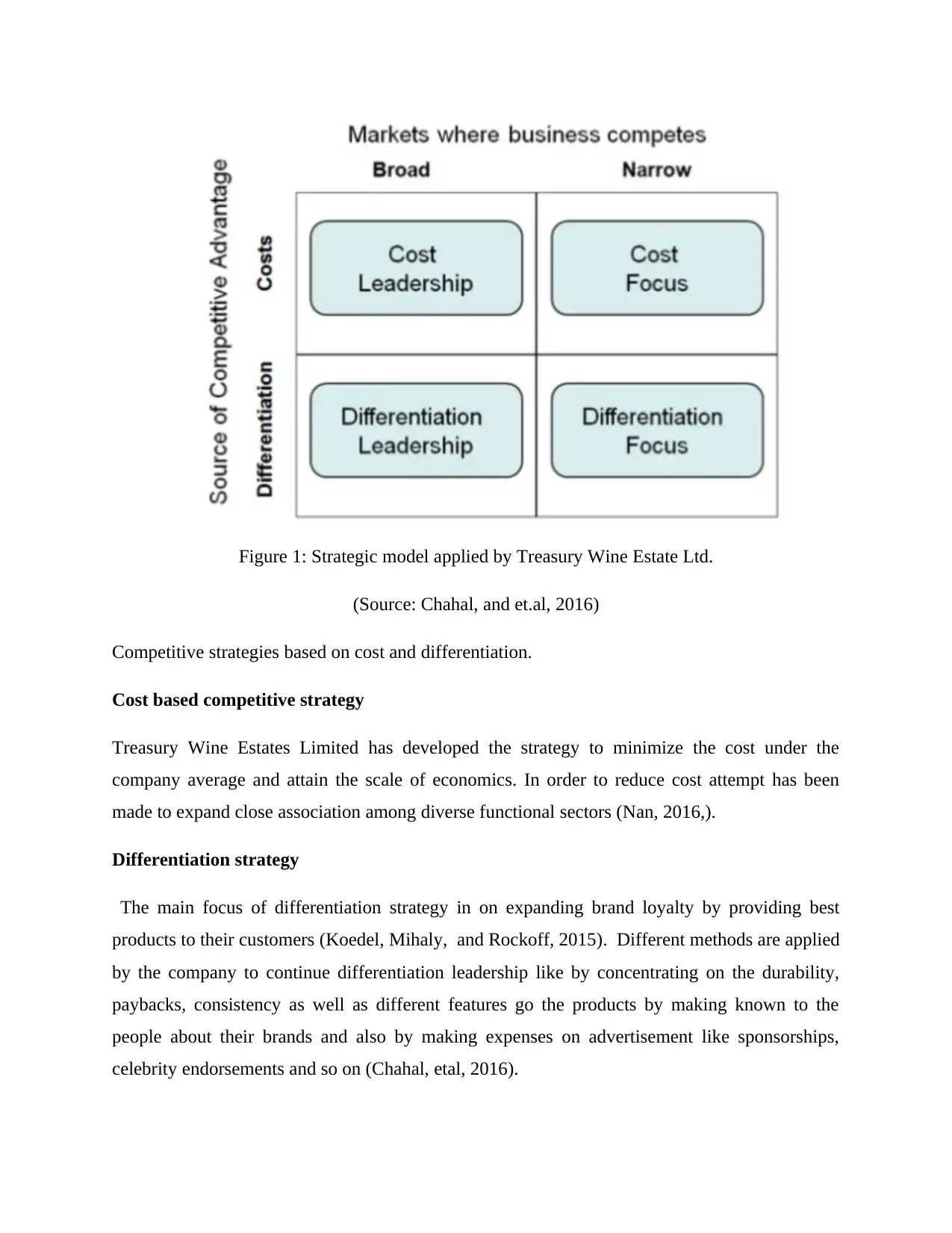
Figure 1: Strategic model applied by Treasury Wine Estate Ltd.
(Source: Chahal, and et.al, 2016)
Competitive strategies based on cost and differentiation.
Cost based competitive strategy
Treasury Wine Estates Limited has developed the strategy to minimize the cost under the
company average and attain the scale of economics. In order to reduce cost attempt has been
made to expand close association among diverse functional sectors (Nan, 2016,).
Differentiation strategy
The main focus of differentiation strategy in on expanding brand loyalty by providing best
products to their customers (Koedel, Mihaly, and Rockoff, 2015). Different methods are applied
by the company to continue differentiation leadership like by concentrating on the durability,
paybacks, consistency as well as different features go the products by making known to the
people about their brands and also by making expenses on advertisement like sponsorships,
celebrity endorsements and so on (Chahal, etal, 2016).
(Source: Chahal, and et.al, 2016)
Competitive strategies based on cost and differentiation.
Cost based competitive strategy
Treasury Wine Estates Limited has developed the strategy to minimize the cost under the
company average and attain the scale of economics. In order to reduce cost attempt has been
made to expand close association among diverse functional sectors (Nan, 2016,).
Differentiation strategy
The main focus of differentiation strategy in on expanding brand loyalty by providing best
products to their customers (Koedel, Mihaly, and Rockoff, 2015). Different methods are applied
by the company to continue differentiation leadership like by concentrating on the durability,
paybacks, consistency as well as different features go the products by making known to the
people about their brands and also by making expenses on advertisement like sponsorships,
celebrity endorsements and so on (Chahal, etal, 2016).
⊘ This is a preview!⊘
Do you want full access?
Subscribe today to unlock all pages.

Trusted by 1+ million students worldwide
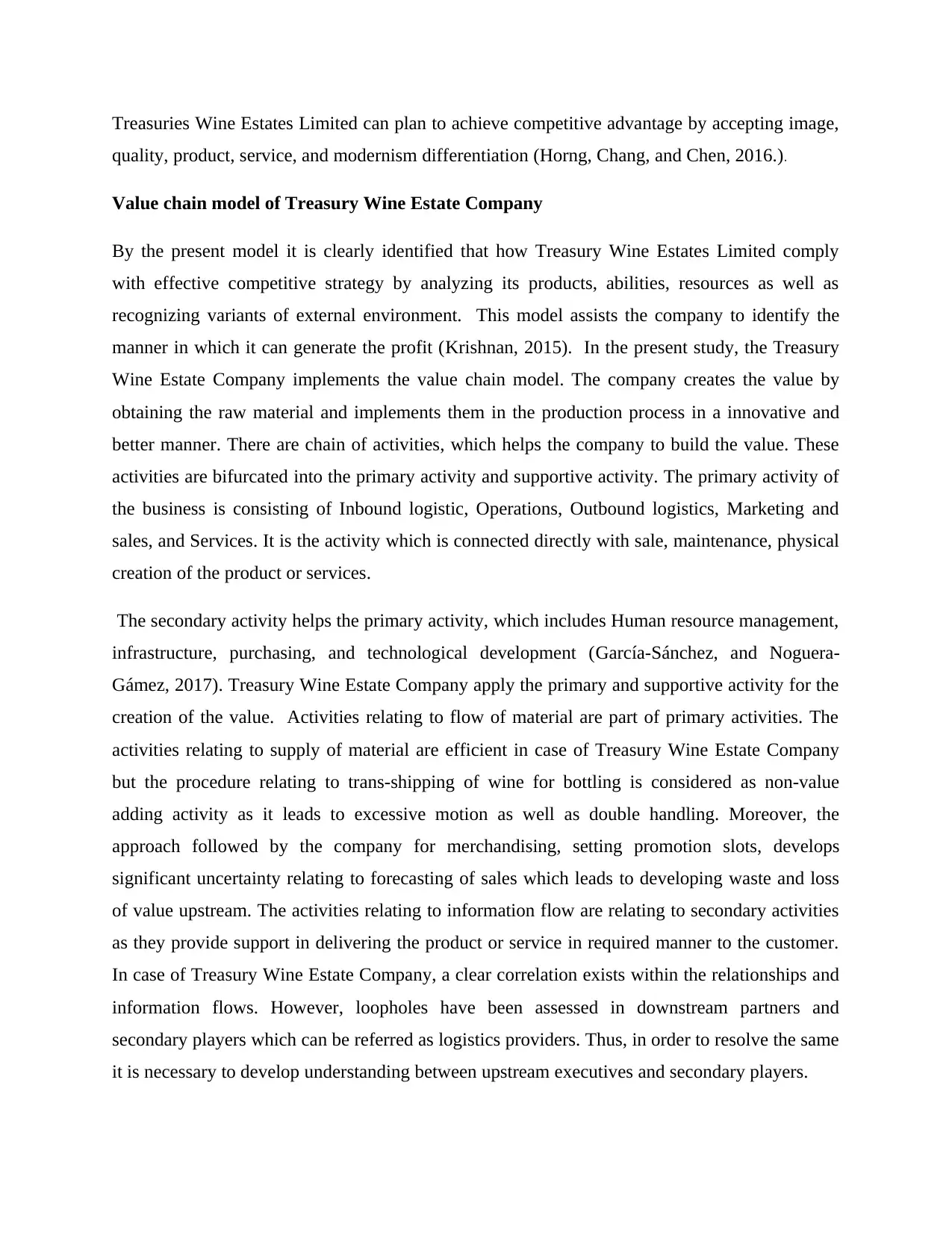
Treasuries Wine Estates Limited can plan to achieve competitive advantage by accepting image,
quality, product, service, and modernism differentiation (Horng, Chang, and Chen, 2016.).
Value chain model of Treasury Wine Estate Company
By the present model it is clearly identified that how Treasury Wine Estates Limited comply
with effective competitive strategy by analyzing its products, abilities, resources as well as
recognizing variants of external environment. This model assists the company to identify the
manner in which it can generate the profit (Krishnan, 2015). In the present study, the Treasury
Wine Estate Company implements the value chain model. The company creates the value by
obtaining the raw material and implements them in the production process in a innovative and
better manner. There are chain of activities, which helps the company to build the value. These
activities are bifurcated into the primary activity and supportive activity. The primary activity of
the business is consisting of Inbound logistic, Operations, Outbound logistics, Marketing and
sales, and Services. It is the activity which is connected directly with sale, maintenance, physical
creation of the product or services.
The secondary activity helps the primary activity, which includes Human resource management,
infrastructure, purchasing, and technological development (García-Sánchez, and Noguera-
Gámez, 2017). Treasury Wine Estate Company apply the primary and supportive activity for the
creation of the value. Activities relating to flow of material are part of primary activities. The
activities relating to supply of material are efficient in case of Treasury Wine Estate Company
but the procedure relating to trans-shipping of wine for bottling is considered as non-value
adding activity as it leads to excessive motion as well as double handling. Moreover, the
approach followed by the company for merchandising, setting promotion slots, develops
significant uncertainty relating to forecasting of sales which leads to developing waste and loss
of value upstream. The activities relating to information flow are relating to secondary activities
as they provide support in delivering the product or service in required manner to the customer.
In case of Treasury Wine Estate Company, a clear correlation exists within the relationships and
information flows. However, loopholes have been assessed in downstream partners and
secondary players which can be referred as logistics providers. Thus, in order to resolve the same
it is necessary to develop understanding between upstream executives and secondary players.
quality, product, service, and modernism differentiation (Horng, Chang, and Chen, 2016.).
Value chain model of Treasury Wine Estate Company
By the present model it is clearly identified that how Treasury Wine Estates Limited comply
with effective competitive strategy by analyzing its products, abilities, resources as well as
recognizing variants of external environment. This model assists the company to identify the
manner in which it can generate the profit (Krishnan, 2015). In the present study, the Treasury
Wine Estate Company implements the value chain model. The company creates the value by
obtaining the raw material and implements them in the production process in a innovative and
better manner. There are chain of activities, which helps the company to build the value. These
activities are bifurcated into the primary activity and supportive activity. The primary activity of
the business is consisting of Inbound logistic, Operations, Outbound logistics, Marketing and
sales, and Services. It is the activity which is connected directly with sale, maintenance, physical
creation of the product or services.
The secondary activity helps the primary activity, which includes Human resource management,
infrastructure, purchasing, and technological development (García-Sánchez, and Noguera-
Gámez, 2017). Treasury Wine Estate Company apply the primary and supportive activity for the
creation of the value. Activities relating to flow of material are part of primary activities. The
activities relating to supply of material are efficient in case of Treasury Wine Estate Company
but the procedure relating to trans-shipping of wine for bottling is considered as non-value
adding activity as it leads to excessive motion as well as double handling. Moreover, the
approach followed by the company for merchandising, setting promotion slots, develops
significant uncertainty relating to forecasting of sales which leads to developing waste and loss
of value upstream. The activities relating to information flow are relating to secondary activities
as they provide support in delivering the product or service in required manner to the customer.
In case of Treasury Wine Estate Company, a clear correlation exists within the relationships and
information flows. However, loopholes have been assessed in downstream partners and
secondary players which can be referred as logistics providers. Thus, in order to resolve the same
it is necessary to develop understanding between upstream executives and secondary players.
Paraphrase This Document
Need a fresh take? Get an instant paraphrase of this document with our AI Paraphraser
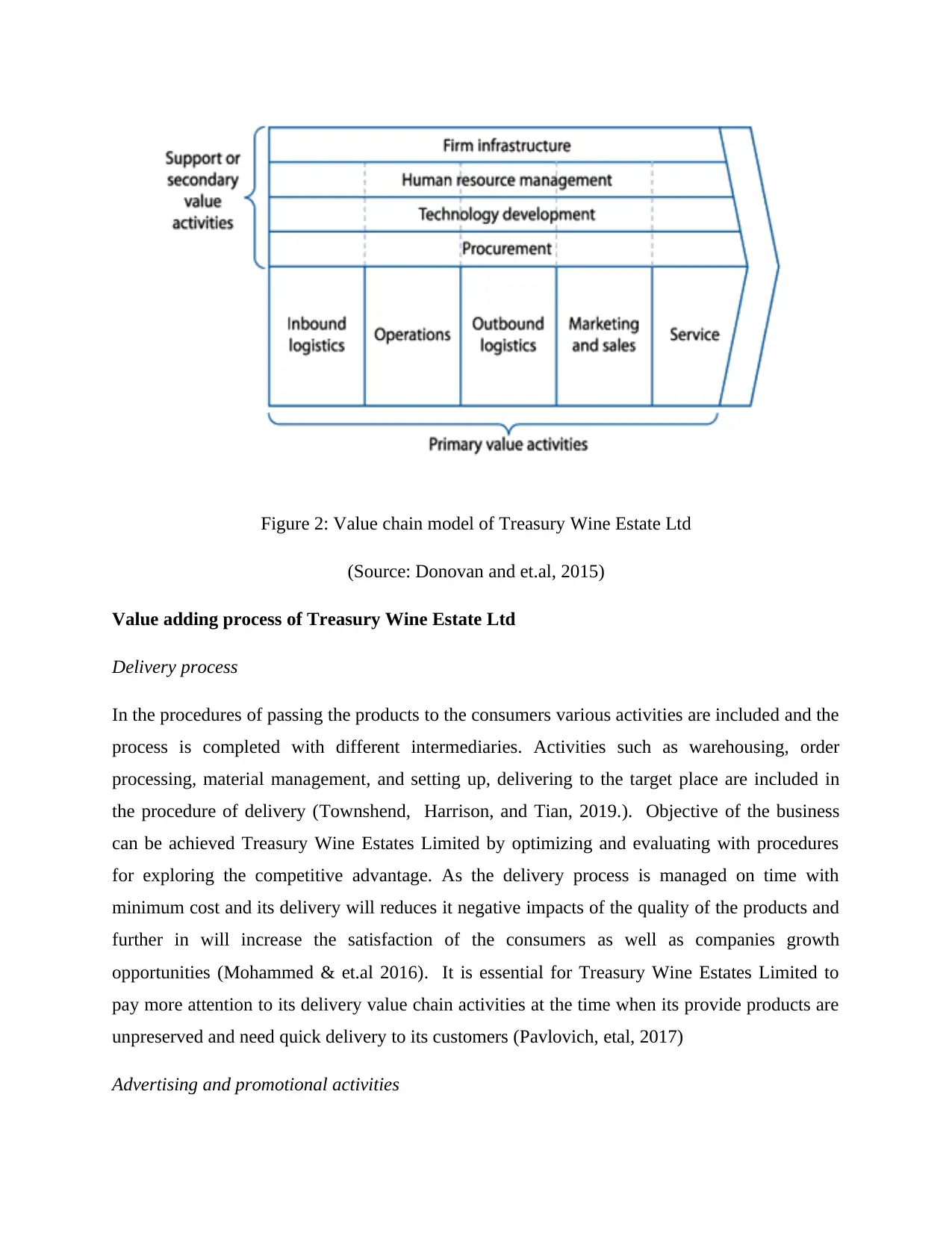
Figure 2: Value chain model of Treasury Wine Estate Ltd
(Source: Donovan and et.al, 2015)
Value adding process of Treasury Wine Estate Ltd
Delivery process
In the procedures of passing the products to the consumers various activities are included and the
process is completed with different intermediaries. Activities such as warehousing, order
processing, material management, and setting up, delivering to the target place are included in
the procedure of delivery (Townshend, Harrison, and Tian, 2019.). Objective of the business
can be achieved Treasury Wine Estates Limited by optimizing and evaluating with procedures
for exploring the competitive advantage. As the delivery process is managed on time with
minimum cost and its delivery will reduces it negative impacts of the quality of the products and
further in will increase the satisfaction of the consumers as well as companies growth
opportunities (Mohammed & et.al 2016). It is essential for Treasury Wine Estates Limited to
pay more attention to its delivery value chain activities at the time when its provide products are
unpreserved and need quick delivery to its customers (Pavlovich, etal, 2017)
Advertising and promotional activities
(Source: Donovan and et.al, 2015)
Value adding process of Treasury Wine Estate Ltd
Delivery process
In the procedures of passing the products to the consumers various activities are included and the
process is completed with different intermediaries. Activities such as warehousing, order
processing, material management, and setting up, delivering to the target place are included in
the procedure of delivery (Townshend, Harrison, and Tian, 2019.). Objective of the business
can be achieved Treasury Wine Estates Limited by optimizing and evaluating with procedures
for exploring the competitive advantage. As the delivery process is managed on time with
minimum cost and its delivery will reduces it negative impacts of the quality of the products and
further in will increase the satisfaction of the consumers as well as companies growth
opportunities (Mohammed & et.al 2016). It is essential for Treasury Wine Estates Limited to
pay more attention to its delivery value chain activities at the time when its provide products are
unpreserved and need quick delivery to its customers (Pavlovich, etal, 2017)
Advertising and promotional activities
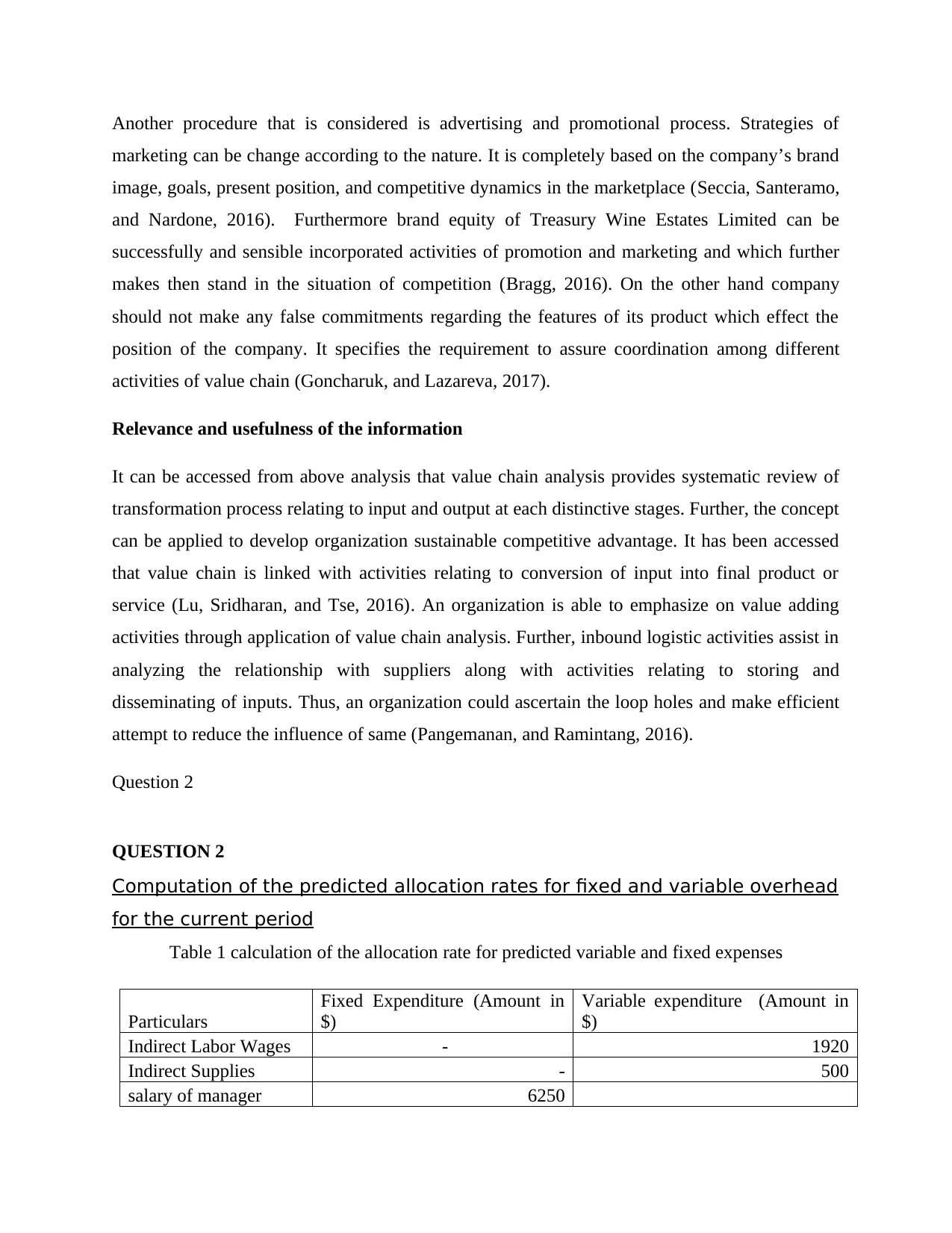
Another procedure that is considered is advertising and promotional process. Strategies of
marketing can be change according to the nature. It is completely based on the company’s brand
image, goals, present position, and competitive dynamics in the marketplace (Seccia, Santeramo,
and Nardone, 2016). Furthermore brand equity of Treasury Wine Estates Limited can be
successfully and sensible incorporated activities of promotion and marketing and which further
makes then stand in the situation of competition (Bragg, 2016). On the other hand company
should not make any false commitments regarding the features of its product which effect the
position of the company. It specifies the requirement to assure coordination among different
activities of value chain (Goncharuk, and Lazareva, 2017).
Relevance and usefulness of the information
It can be accessed from above analysis that value chain analysis provides systematic review of
transformation process relating to input and output at each distinctive stages. Further, the concept
can be applied to develop organization sustainable competitive advantage. It has been accessed
that value chain is linked with activities relating to conversion of input into final product or
service (Lu, Sridharan, and Tse, 2016). An organization is able to emphasize on value adding
activities through application of value chain analysis. Further, inbound logistic activities assist in
analyzing the relationship with suppliers along with activities relating to storing and
disseminating of inputs. Thus, an organization could ascertain the loop holes and make efficient
attempt to reduce the influence of same (Pangemanan, and Ramintang, 2016).
Question 2
QUESTION 2
Computation of the predicted allocation rates for fixed and variable overhead
for the current period
Table 1 calculation of the allocation rate for predicted variable and fixed expenses
Particulars
Fixed Expenditure (Amount in
$)
Variable expenditure (Amount in
$)
Indirect Labor Wages - 1920
Indirect Supplies - 500
salary of manager 6250
marketing can be change according to the nature. It is completely based on the company’s brand
image, goals, present position, and competitive dynamics in the marketplace (Seccia, Santeramo,
and Nardone, 2016). Furthermore brand equity of Treasury Wine Estates Limited can be
successfully and sensible incorporated activities of promotion and marketing and which further
makes then stand in the situation of competition (Bragg, 2016). On the other hand company
should not make any false commitments regarding the features of its product which effect the
position of the company. It specifies the requirement to assure coordination among different
activities of value chain (Goncharuk, and Lazareva, 2017).
Relevance and usefulness of the information
It can be accessed from above analysis that value chain analysis provides systematic review of
transformation process relating to input and output at each distinctive stages. Further, the concept
can be applied to develop organization sustainable competitive advantage. It has been accessed
that value chain is linked with activities relating to conversion of input into final product or
service (Lu, Sridharan, and Tse, 2016). An organization is able to emphasize on value adding
activities through application of value chain analysis. Further, inbound logistic activities assist in
analyzing the relationship with suppliers along with activities relating to storing and
disseminating of inputs. Thus, an organization could ascertain the loop holes and make efficient
attempt to reduce the influence of same (Pangemanan, and Ramintang, 2016).
Question 2
QUESTION 2
Computation of the predicted allocation rates for fixed and variable overhead
for the current period
Table 1 calculation of the allocation rate for predicted variable and fixed expenses
Particulars
Fixed Expenditure (Amount in
$)
Variable expenditure (Amount in
$)
Indirect Labor Wages - 1920
Indirect Supplies - 500
salary of manager 6250
⊘ This is a preview!⊘
Do you want full access?
Subscribe today to unlock all pages.

Trusted by 1+ million students worldwide
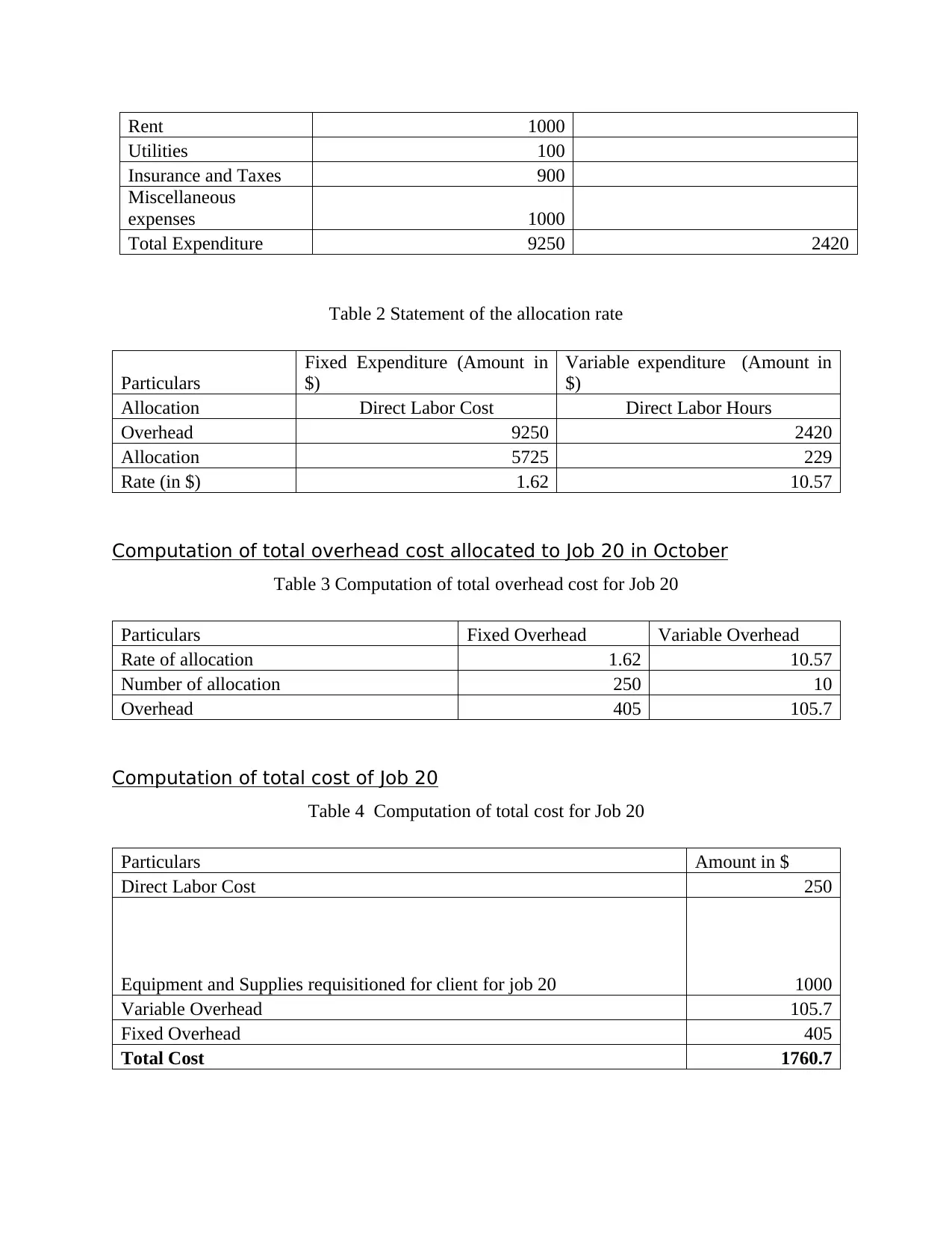
Rent 1000
Utilities 100
Insurance and Taxes 900
Miscellaneous
expenses 1000
Total Expenditure 9250 2420
Table 2 Statement of the allocation rate
Particulars
Fixed Expenditure (Amount in
$)
Variable expenditure (Amount in
$)
Allocation Direct Labor Cost Direct Labor Hours
Overhead 9250 2420
Allocation 5725 229
Rate (in $) 1.62 10.57
Computation of total overhead cost allocated to Job 20 in October
Table 3 Computation of total overhead cost for Job 20
Particulars Fixed Overhead Variable Overhead
Rate of allocation 1.62 10.57
Number of allocation 250 10
Overhead 405 105.7
Computation of total cost of Job 20
Table 4 Computation of total cost for Job 20
Particulars Amount in $
Direct Labor Cost 250
Equipment and Supplies requisitioned for client for job 20 1000
Variable Overhead 105.7
Fixed Overhead 405
Total Cost 1760.7
Utilities 100
Insurance and Taxes 900
Miscellaneous
expenses 1000
Total Expenditure 9250 2420
Table 2 Statement of the allocation rate
Particulars
Fixed Expenditure (Amount in
$)
Variable expenditure (Amount in
$)
Allocation Direct Labor Cost Direct Labor Hours
Overhead 9250 2420
Allocation 5725 229
Rate (in $) 1.62 10.57
Computation of total overhead cost allocated to Job 20 in October
Table 3 Computation of total overhead cost for Job 20
Particulars Fixed Overhead Variable Overhead
Rate of allocation 1.62 10.57
Number of allocation 250 10
Overhead 405 105.7
Computation of total cost of Job 20
Table 4 Computation of total cost for Job 20
Particulars Amount in $
Direct Labor Cost 250
Equipment and Supplies requisitioned for client for job 20 1000
Variable Overhead 105.7
Fixed Overhead 405
Total Cost 1760.7
Paraphrase This Document
Need a fresh take? Get an instant paraphrase of this document with our AI Paraphraser
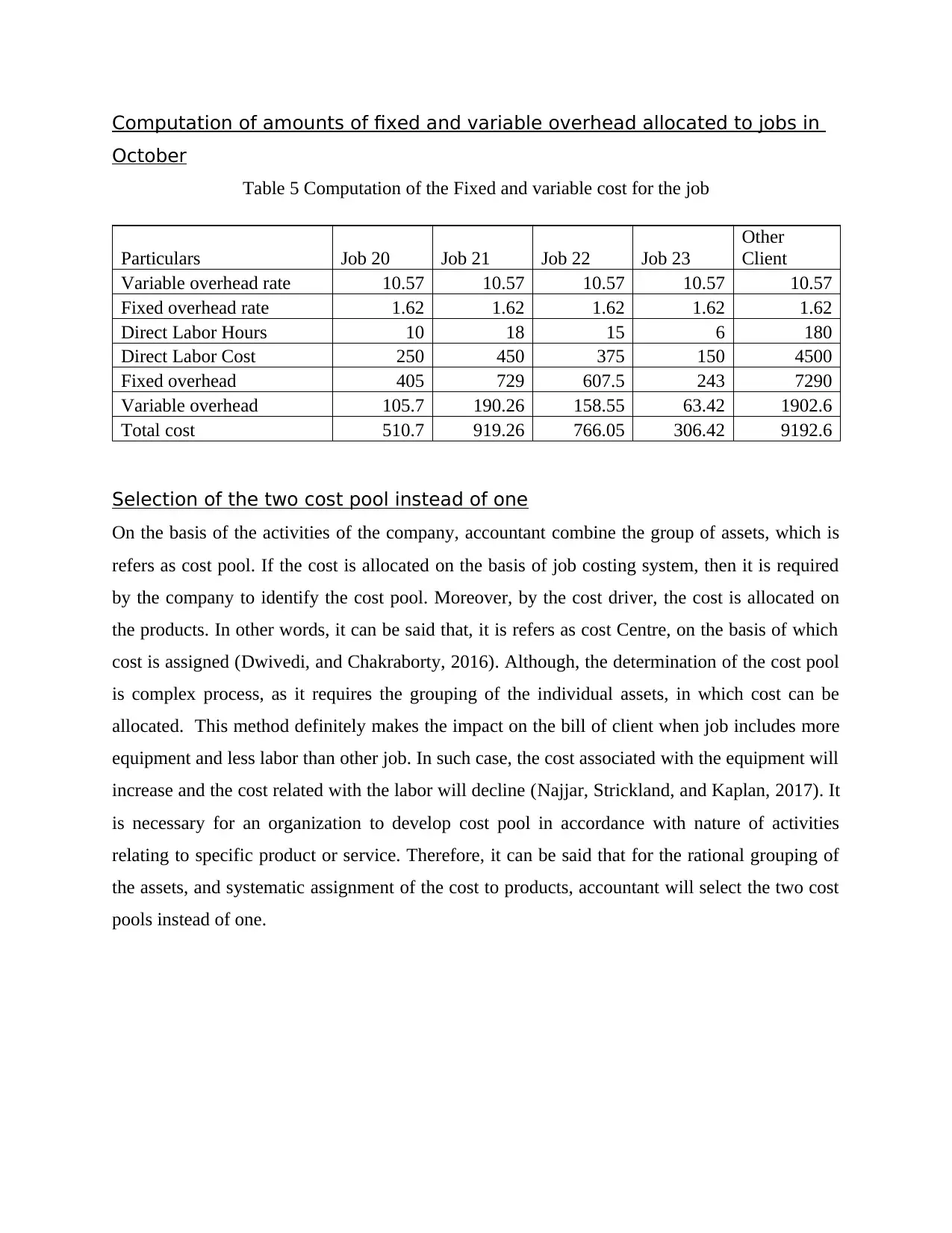
Computation of amounts of fixed and variable overhead allocated to jobs in
October
Table 5 Computation of the Fixed and variable cost for the job
Particulars Job 20 Job 21 Job 22 Job 23
Other
Client
Variable overhead rate 10.57 10.57 10.57 10.57 10.57
Fixed overhead rate 1.62 1.62 1.62 1.62 1.62
Direct Labor Hours 10 18 15 6 180
Direct Labor Cost 250 450 375 150 4500
Fixed overhead 405 729 607.5 243 7290
Variable overhead 105.7 190.26 158.55 63.42 1902.6
Total cost 510.7 919.26 766.05 306.42 9192.6
Selection of the two cost pool instead of one
On the basis of the activities of the company, accountant combine the group of assets, which is
refers as cost pool. If the cost is allocated on the basis of job costing system, then it is required
by the company to identify the cost pool. Moreover, by the cost driver, the cost is allocated on
the products. In other words, it can be said that, it is refers as cost Centre, on the basis of which
cost is assigned (Dwivedi, and Chakraborty, 2016). Although, the determination of the cost pool
is complex process, as it requires the grouping of the individual assets, in which cost can be
allocated. This method definitely makes the impact on the bill of client when job includes more
equipment and less labor than other job. In such case, the cost associated with the equipment will
increase and the cost related with the labor will decline (Najjar, Strickland, and Kaplan, 2017). It
is necessary for an organization to develop cost pool in accordance with nature of activities
relating to specific product or service. Therefore, it can be said that for the rational grouping of
the assets, and systematic assignment of the cost to products, accountant will select the two cost
pools instead of one.
October
Table 5 Computation of the Fixed and variable cost for the job
Particulars Job 20 Job 21 Job 22 Job 23
Other
Client
Variable overhead rate 10.57 10.57 10.57 10.57 10.57
Fixed overhead rate 1.62 1.62 1.62 1.62 1.62
Direct Labor Hours 10 18 15 6 180
Direct Labor Cost 250 450 375 150 4500
Fixed overhead 405 729 607.5 243 7290
Variable overhead 105.7 190.26 158.55 63.42 1902.6
Total cost 510.7 919.26 766.05 306.42 9192.6
Selection of the two cost pool instead of one
On the basis of the activities of the company, accountant combine the group of assets, which is
refers as cost pool. If the cost is allocated on the basis of job costing system, then it is required
by the company to identify the cost pool. Moreover, by the cost driver, the cost is allocated on
the products. In other words, it can be said that, it is refers as cost Centre, on the basis of which
cost is assigned (Dwivedi, and Chakraborty, 2016). Although, the determination of the cost pool
is complex process, as it requires the grouping of the individual assets, in which cost can be
allocated. This method definitely makes the impact on the bill of client when job includes more
equipment and less labor than other job. In such case, the cost associated with the equipment will
increase and the cost related with the labor will decline (Najjar, Strickland, and Kaplan, 2017). It
is necessary for an organization to develop cost pool in accordance with nature of activities
relating to specific product or service. Therefore, it can be said that for the rational grouping of
the assets, and systematic assignment of the cost to products, accountant will select the two cost
pools instead of one.
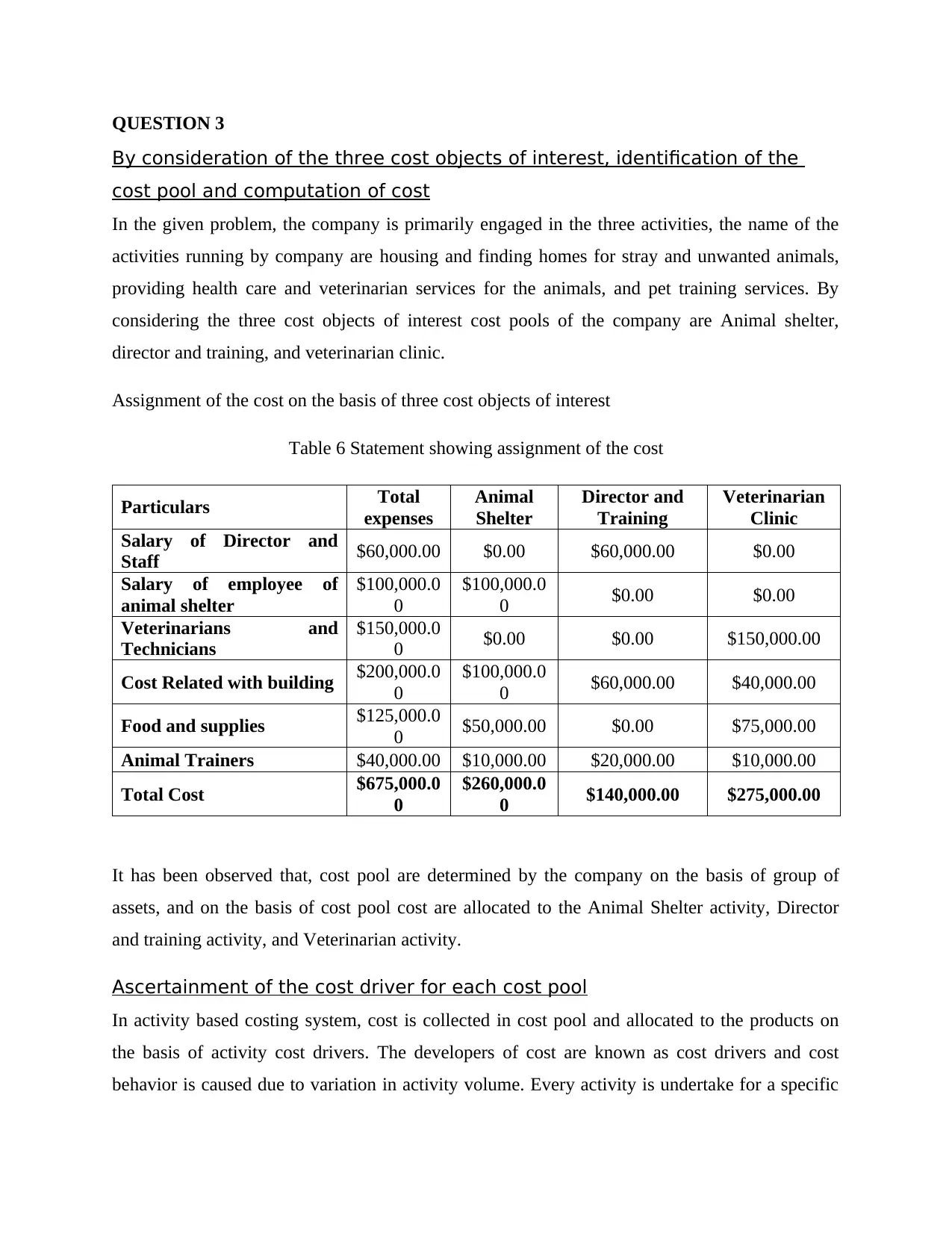
QUESTION 3
By consideration of the three cost objects of interest, identification of the
cost pool and computation of cost
In the given problem, the company is primarily engaged in the three activities, the name of the
activities running by company are housing and finding homes for stray and unwanted animals,
providing health care and veterinarian services for the animals, and pet training services. By
considering the three cost objects of interest cost pools of the company are Animal shelter,
director and training, and veterinarian clinic.
Assignment of the cost on the basis of three cost objects of interest
Table 6 Statement showing assignment of the cost
Particulars Total
expenses
Animal
Shelter
Director and
Training
Veterinarian
Clinic
Salary of Director and
Staff $60,000.00 $0.00 $60,000.00 $0.00
Salary of employee of
animal shelter
$100,000.0
0
$100,000.0
0 $0.00 $0.00
Veterinarians and
Technicians
$150,000.0
0 $0.00 $0.00 $150,000.00
Cost Related with building $200,000.0
0
$100,000.0
0 $60,000.00 $40,000.00
Food and supplies $125,000.0
0 $50,000.00 $0.00 $75,000.00
Animal Trainers $40,000.00 $10,000.00 $20,000.00 $10,000.00
Total Cost $675,000.0
0
$260,000.0
0 $140,000.00 $275,000.00
It has been observed that, cost pool are determined by the company on the basis of group of
assets, and on the basis of cost pool cost are allocated to the Animal Shelter activity, Director
and training activity, and Veterinarian activity.
Ascertainment of the cost driver for each cost pool
In activity based costing system, cost is collected in cost pool and allocated to the products on
the basis of activity cost drivers. The developers of cost are known as cost drivers and cost
behavior is caused due to variation in activity volume. Every activity is undertake for a specific
By consideration of the three cost objects of interest, identification of the
cost pool and computation of cost
In the given problem, the company is primarily engaged in the three activities, the name of the
activities running by company are housing and finding homes for stray and unwanted animals,
providing health care and veterinarian services for the animals, and pet training services. By
considering the three cost objects of interest cost pools of the company are Animal shelter,
director and training, and veterinarian clinic.
Assignment of the cost on the basis of three cost objects of interest
Table 6 Statement showing assignment of the cost
Particulars Total
expenses
Animal
Shelter
Director and
Training
Veterinarian
Clinic
Salary of Director and
Staff $60,000.00 $0.00 $60,000.00 $0.00
Salary of employee of
animal shelter
$100,000.0
0
$100,000.0
0 $0.00 $0.00
Veterinarians and
Technicians
$150,000.0
0 $0.00 $0.00 $150,000.00
Cost Related with building $200,000.0
0
$100,000.0
0 $60,000.00 $40,000.00
Food and supplies $125,000.0
0 $50,000.00 $0.00 $75,000.00
Animal Trainers $40,000.00 $10,000.00 $20,000.00 $10,000.00
Total Cost $675,000.0
0
$260,000.0
0 $140,000.00 $275,000.00
It has been observed that, cost pool are determined by the company on the basis of group of
assets, and on the basis of cost pool cost are allocated to the Animal Shelter activity, Director
and training activity, and Veterinarian activity.
Ascertainment of the cost driver for each cost pool
In activity based costing system, cost is collected in cost pool and allocated to the products on
the basis of activity cost drivers. The developers of cost are known as cost drivers and cost
behavior is caused due to variation in activity volume. Every activity is undertake for a specific
⊘ This is a preview!⊘
Do you want full access?
Subscribe today to unlock all pages.

Trusted by 1+ million students worldwide
1 out of 17
Related Documents
Your All-in-One AI-Powered Toolkit for Academic Success.
+13062052269
info@desklib.com
Available 24*7 on WhatsApp / Email
![[object Object]](/_next/static/media/star-bottom.7253800d.svg)
Unlock your academic potential
Copyright © 2020–2025 A2Z Services. All Rights Reserved. Developed and managed by ZUCOL.




